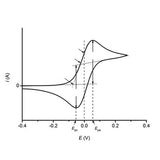Platinum Disc Working Electrode
Electrochemistry Supplies, Electrodes, Equipment Accessories,High quality platinum disc working electrodes
Perfect for use in standard electrochemistry cells for cyclic voltammetry and more
Overview | Specifications | Pricing and Options
Platinum disc working electrodes have high resistance to oxidation in both air and acids, which is why they are widely used in standard electrochemistry cells for cyclic voltammetry, linear sweep voltammetry and investigation for the oxidation and reduction potentials of organic and inorganic semiconductors. Organic semiconductors such as polymers in solution can be drop-cast onto the disc to form films, or alternatively the electrochemical cell can be set up to measure the properties of a material in solution. Both platinum and gold disc working electrodes are easy to use and clean.
Solvent and acid resistant working electrodes are available to buy with either a highly polished platinum (included with our potentiostat) or gold disc embedded in polytetrafluoroethylene (PTFE) or Polyether ether ketone (PEEK) plastic bodies. Save up to 5% and 10% per electrode when you buy packs of five and ten respectively or get three electrodes and cell glassware with an electrochemical cell kit.
For L-shaped and net platinum electrodes, please contact us.
Specifications
All dimensions are in millimeters.
| Available disc diameter (n) size(s) | 1 mm 2 mm 3 mm 4 mm |
| Purity | 99.99% |
Pricing and Options
| Product Name | Product Code | Price |
| Platinum Disc Working Electrode - 2 mm diameter - PTFE Body - Single | C2013A1 | £210 |
| Platinum Disc Working Electrode - 2 mm diameter - PTFE Body - Pack of 5 | C2013A1-5 | £1050 |
| Platinum Disc Working Electrode - 2 mm diameter - PTFE Body - Pack of 10 | C2013A1-10 | £1900 |
| Platinum Disc Working Electrode - 1 mm diameter - PTFE Body | C2013C1 | £165 |
| Platinum Disc Working Electrode - 3 mm diameter - PTFE Body | C2013D1 | £260 |
| Platinum Disc Working Electrode - 4 mm diameter - PTFE Body | C2013E1 | £370 |
| Platinum Disc Working Electrode - 2 mm diameter - PEEK Body | C2019A1 | £280 |
| Electrochemical Cell Kit with Electrodes | C2016A1 | £560 |
| Luggin Capillary Electrochemical Cell Kit with Electrodes | C2016B1 | £620 |
Learn More
 PEEK vs PTFE
PEEK vs PTFE
The choice of whether to use PEEK (polyether ether ketone) or PTFE (polytetrafluoroethylene, Teflon) comes down to the conditions of your planned experiments. The key polymer properties to consider are:
Read more... Cyclic Voltammetry Basics, Setup, and Applications
Cyclic Voltammetry Basics, Setup, and Applications
Cyclic voltammetry is an electrochemical technique for measuring the current response of a redox active solution to a linearly cycled potential sweep between two or more set values.
Read more...